The on-demand talent economy has experienced significant growth over the last decade, thanks to technological advancement to collaborate seamlessly and an increase in the talent supply who are looking for independent projects. However, the demand is still lagging owing to the lack of trust in onboarding independent talent. We believe that the industry is at a cusp as the talent platforms incorporate diligent processes and advanced tech to eliminate three major bottlenecks for organizations – fast discovery of the right talent, quality delivery of the projects, and seamless knowledge transfer to retain expertise. We propose a simple mental model, for an organization of various types and maturity, of leveraging the gig model and utilizing the power of on-demand expertise for augmenting the choked workforce and pushing for rapid innovation where one should not scale in-house teams without the market fit of proposed initiatives.
Introduction
The on-demand economy has been around us for decades. Its steadfast growth drivers are complex, but technology is one of the significant catalysts. The technology allows us to amass a group of individuals with similar interests and capabilities and get specific pieces of work executed at scale. It was easier to put on-demand wrappers on relatively more straightforward tasks such as taking us from place A to B, getting groceries, etc. With the advent of sophisticated tech and tools around open communication, project management, and now generative AI, accessing and getting far more complex tasks done through such a model at scale is becoming a possibility.
The bare-bone rationale for the demand for such a model is the possibility of accessing a service when one wants it with ease, and cost-effectively. Accessing the knowledge workforce in such a transactional manner at the outset seemed bizarre. Erstwhile, organizations believed in acquiring talent or contracting specialized agencies – this is still how most work gets done within an organization. The central concern of leveraging independent talent is Trust – in expertise, quality, commitment to deliver on time, getting along with the organization’s culture, and data confidentiality.
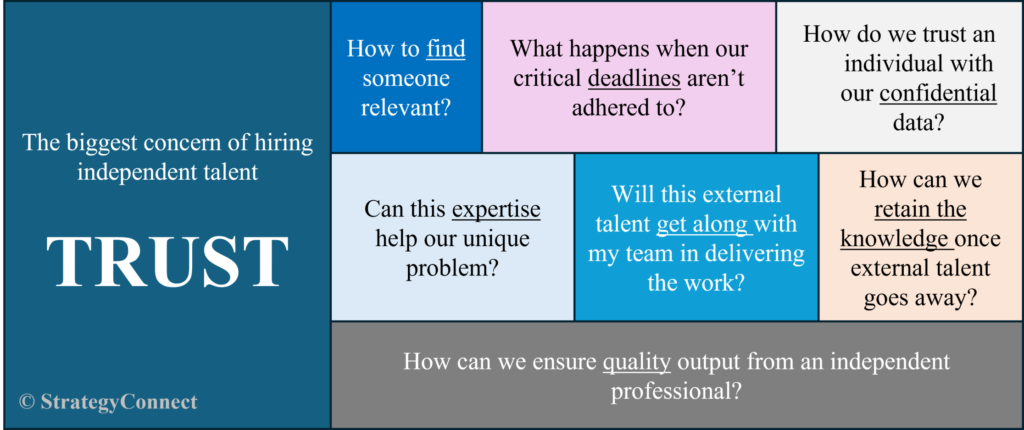
With the exponential increase in the independent workforce, talent & recruitment platforms have innovated, both process and technologically, to ensure high-quality matching, addressing the concerns. As of 2023, there are estimated to be 250-280 million knowledge workers, of which 90-100 million take up independent assignments in a full-time/ part-time fashion, generating a $1 trillion economy.
The transactional nature of the on-demand model has started to make sense for the rising knowledge workforce as both parties involved understand the terms well. The demand side gets a business problem solved, and the supply side gets the flexibility of managing their workload. The case is getting bullish as technology supports the development further, enabling us to visualize the future of work and how the workforce could be structured in the coming decades with further trust and seamless collaboration.
The Genesis
Let’s look at an organization – it primarily comprises people aligned to a unified vision in delivering a product/ service to its customers. Along the way, it incurs various costs categorized as internal or external. Internal costs are borne when internal resources are spent to fire up a certain part of the value chain; external costs are borne when external resources are leveraged to execute the remaining part of the value chain. The Coase theory explores how an organization decides what kind of transactions to keep internal vs external.
This is a pure-play economic consideration. A few decades ago, questions were more fundamental, e.g., owning a metal mining site vs. procuring it from miners in producing a finished product, e.g., steel. With technology and distribution networks expanding, organizations are prioritizing what activities and functions to keep as core and hiving off other aspects to external parties to keep the business asset optimized, maximizing shareholders’ value.
The first wave was externalizing asset verticals, e.g., energy assets. The next waves have been around leveraging specialized product and service firms providing horizontal or verticalized solutions, e.g., logistics SaaS, and accounting boutiques, followed by one of the hardest changes of putting people under the microscope of such economic consideration and exploring ways to leverage the gig model to keep costs low and impact high.
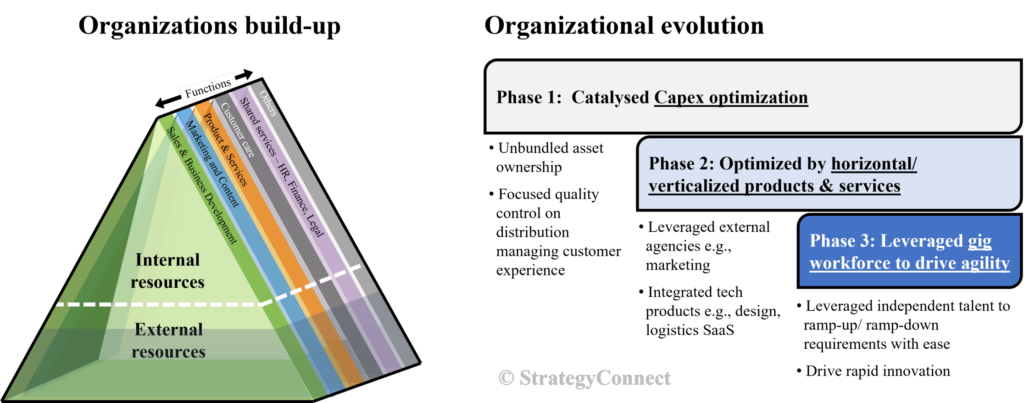
This organizational evolution is causing organizations to atomize. Most organizations are leveraging any and every type of partnership and augmentation to keep the pool of internal resources optimized.
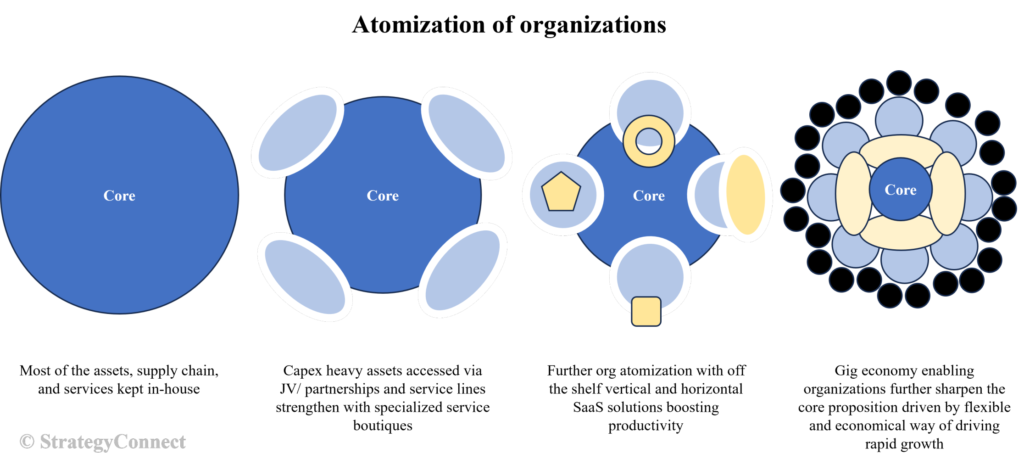
The mental model for leveraging the gig model
Organizations have various ways to tap into the potential of such a flexible workforce. The key is that such talent onboarding is poised for two scenarios – a) augmenting the core, and b) innovation sprints. One must avoid using the gig workforce to replace the core workforce except for ventures in the early stages where the organization is just getting built.
Augmenting the core implies supporting the core teams with additional resources that once can ramp up or down rapidly to drive execution. This scenario enables an organization to retain the ownership of the initiative in-house. This further helps set the tone that external resources are not setting the direction but just supplying an extra pair of strong hands to the assigned leader/ manager. An innovation sprint implies forming a band of a dynamic team, though with a clear owner/ manager required at the organization, to rapidly test certain ideas where a full-time team building is a bit too early before establishing the feasibility and certainty of an idea/ initiative.
These two scenarios have a driving force, i.e., capital and the maturity of an organization trying to tap into the potential of the flexible workforce.
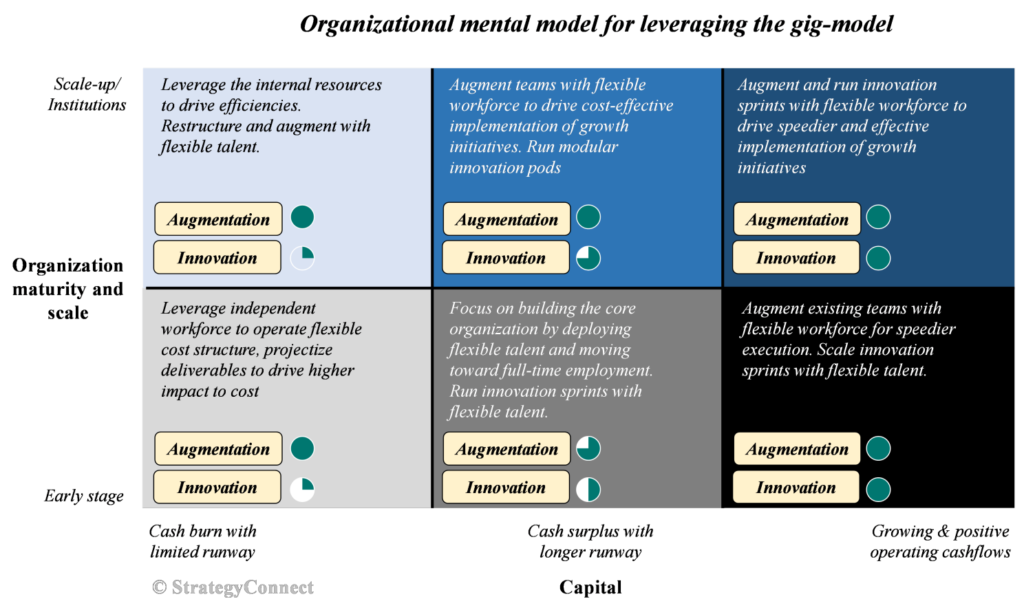
To understand this fully, the exhibit above attempts to lay out the different scenarios. As an example, a scaled-up institution with a critical cash situation should stay focused on enhancing the efficiencies of internal resources, restructure the workforce, and leverage flexible workforce to augment and take advantage of the cost efficiencies that come with it.
If we flip the argument as articulated by the late Charlie Munger – “Invert, always invert” – a mental model inspired by algebraist Carl Jacobi: if organizations don’t access the flexible workforce and keep hiring for specific expertise in all initiatives then they will end up building an organization with bloated people cost with a likely scenario of sudden restructuring realizing that requirements and people support structure is not sustainable.
Band of high performers around the core – augmentation
An organization must define the critical few/ core people who are prime owners of the vision around which layers of on-demand support can be deployed to further the leverage for the core. The use cases are plenty and the business leaders need to identify and leverage the expertise getting offered on an on-demand basis.
I am the marketing head of an omnichannel venture. My team is lean, runs channel performance, and collaborates with the product team. I onboarded an ex-product marketing strategist from booking.com for 2 days to figure out how to tie performance analytics on potential product A/B test-oriented changes to further optimize CAC.
I am a finance leader with a team of one financial controller and 3 junior accountants focused on day-to-day accounting operations, book closing, and VAT/ tax filing responsibilities. I onboarded two FP&A experts in building three scenarios on effective management of the cash cycle focused on AP/ AR optimization per supplier, and product level unit economics template for the category team.
I am an entrepreneur raising seed capital for my venture. I was asked by an investor to provide 2-3 scenarios on the financial plan based on growth milestones. I onboarded an ex-VC associate for a week to chalk out key drivers and potential changing funding needs.
I am a new market launch manager with my internal team operating with multiple new Business heads. I onboarded a business analyst for 2 weeks to conduct a competitive landscape covering pricing benchmarks and top customers in a new market to draft the launch plan.
The use cases are plenty and need clear direction and drive from the respective leader to drive efficiency for an organization.
Scaling organization the way we scale products – innovation sprint
We have embedded the ethos of iterations in the way we build scalable products today. We strongly believe the same principles can be applied to scaling people infrastructure at an organization. What does it mean? For new initiatives that are yet to be proven and scale, organizations should leverage the flexible workforce to create the foundations of the offering and iterate the said offering till a market fit is realized post which building the core team takes the driving seat with flexible workforce involvement switching gears from innovation sprint to augmentation.
I am an e-commerce venture focusing on pre-loved luxury product deals. To scale further, we want to foray into a full-price marketplace model. We onboarded a team of commercial and buying experts to secure inventory for 6 months on a consignment basis and gain initial traction for 3 months before onboarding the full business development team targeting more partners and suppliers.
I am an ad tech venture optimizing channel spending based on proprietary algorithms. With the customer database increasing, we would like to cross-sell ad space within our customer base to deliver higher efficiencies, upsell services, and monetize the network. We onboarded a team of product owners, and business development executives for 10 months to work closely with our engineering and commercial team and secure the first 10 customers.
Solving for trust. Bringing on-demand talent at par with full-time employees
Going back to the adoption framework and how trust is the centerpiece of the puzzle.
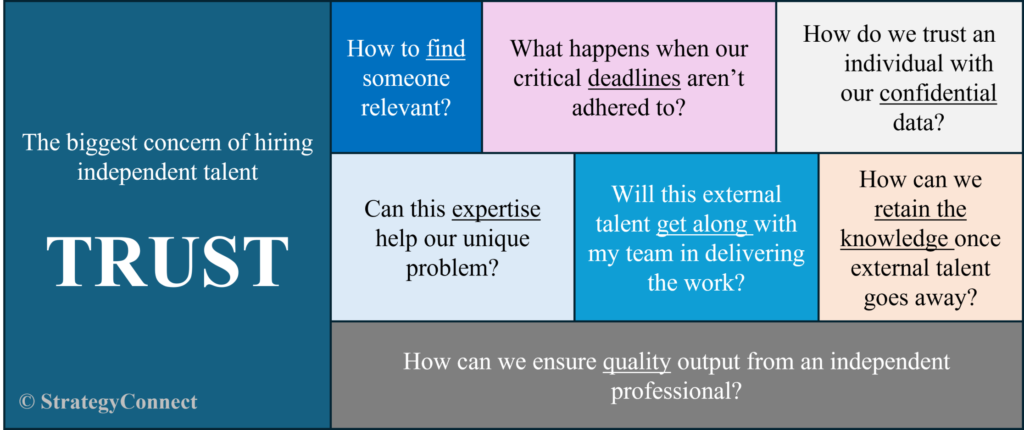
To understand this better, one can break down the different stages as organizations think of adopting the flexible workforce at scale.
Discovery: This is a high-friction step. The most preferred channel is the recommendation from own network. This resistance exists in full-time recruitment too but with flexible deployment finding the talent pipeline is an endless endeavor that adds to the complexity. The talent platforms have come a long way in refining the vetting process. At StrategyConnect, we have defined 8 indicators to rank the relevancy of the profile against a project ask leaving us with less than 1% of the talent relevant for a client from an already curated base, and that too provided within 24-48 hours. Speed and quality become the key to unlocking the value for organizations.

Delivery: This, to some extent, remains the core of inhibition for organizations to adopt the flexible talent base. To address this comprehensively, organizations ask for proof of work (instead of lengthy assessment case studies/ projects) and ensure that the talent platform supports quick changes in case delivery quality is compromised. StrategyConnect deploys feedback loops and allocates a dedicated administrative team to drive proactive troubleshooting.

Knowledge transfer (KT): What happens when the deployed expert leaves? Be it for augmentation or innovation sprints (please refer to the Organizational mental model for leveraging the gig model exhibit), talent platforms put in place a clearly defined handover process to ensure no IP is lost in translation. StrategyConnect has built the KM library to ensure deliverables and process IPs are handed over.

Conclusion
The time of the independent workforce has come. Organizations leveraging and learning how to deploy on-demand talent networks at pace and scale will develop a strong competitive edge over time.
About StrategyConnect
StrategyConnect deploys specialized talent on demand. As one of the largest networks of independent consultants and industry experts, we are driving the adoption of a flexible workforce across the Middle East. Our platform is designed with one goal in mind: to rapidly connect organizations with the precise expertise they need. To learn more, visit strategyconnect.co




